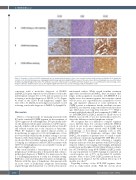Page 208 - 2021_06-Haematologica-web
P. 208
J. Svoboda et al.
A
B
C
Figure 3. Examples of different CD30 staining patterns by immunohistochemistry in three representative patients with primary mediastinal B-cell lymphoma enrolled on the trial. (A) Heterogeneous staining pattern with strong and dim staining in different areas of the same tumor. (B) Focal staining in one area of the tumor. (C) Diffuse staining throughout the tumor. The antibodies used were CD20 (ready to use, DAKO) and CD30 (ready to use, Leica) and they were detected using a chro- mogenic substrate, diaminobenzene (Leica). An original magnification x200 was used for all images. H&E: hematoxylin & eosin.
consistent with a molecular diagnosis of PMBCL (mPMBCL) by gene expression; two patients scored in the indeterminate category (0.1 to 0.9); and one patient scored as having a molecular diagnosis of DLBCL (< 0.1) (Figure 4). None of the CD30+ B-cell lymphoma samples that were felt to be DLBCL by investigator assessment scored as having a molecular diagnosis of PMBCL by Lymph3Cx.
Discussion
There is a strong rationale for replacing vincristine with BV in the standard R-CHOP regimen for the treatment of CD30+ aggressive B-cell lymphomas. BV specifically deliv- ers the antimicrotubule agent auristatin to CD30-express- ing cells, which could result in improved efficacy from BV and reduced toxicity due to the omission of vincristine. While BV displayed only limited clinical activity as monotherapy in aggressive r/r B-cell lymphomas, it has not been widely studied in the frontline setting or in com- bination with chemotherapy.24,29 In our phase I/II study, we showed that a frontline regimen using BV at a dose of 1.8 mg/kg in combination with R-CHP for patients with CD30+ B-cell lymphomas has an acceptable toxicity pro- file and is highly active.
Our study included a heterogeneous group of B-cell lymphomas, but the majority of the patients had a clinico- pathological diagnosis of PMBCL. For many reasons, this is a challenging population to study in a frontline setting. PMBCL is a rare and clinically heterogeneous lymphoma. Patients with this type of lymphoma often present with an acute onset of pulmonary symptoms necessitating urgent therapy which may lead to a selection bias in non-
randomized studies. While several frontline treatment approaches are effective in PMBCL, there are unique chal- lenges in this population of patients. DA-EPOCH-R is a highly active dose-intense regimen, but it requires central venous access, use of growth factors, frequent blood test- ing, and inpatient admission at some institutions. R- CHOP is easier to administer, but the excellent outcomes in PMBCL are achieved using consolidative radiation ther- apy, which may cause long-term toxicities.14,16,30,31 While a recently published phase III trial comparing R-CHOP ver- sus DA-EPOCH-R in DLBCL included a small cohort of PMBCL cases (n=35), it was not statistically powered to detect the differences in this lymphoma subtype.17
We recognize that it is difficult to compare regimens across different trials, but outcomes within the PMBCL cohort in our study are comparable to previously pub- lished results for patients treated with R-CHOP with radiotherapy or dose-intense regimens such as DA- EPOCH-R.14-16,19,30,32 For lymphoma subtypes other than PMBCL, the numbers of patients were too small to make any efficacy conclusions regarding BV-R-CHP. One of two patients with GZL relapsed after achieving a complete response and none of the five patients with CD30+ DLBCL relapsed, which is encouraging. Interestingly, preliminary results from another phase II trial (ClinicalTrial.gov identi- fier: NCT01925612) using BV-R-CHOP in DLBCL (with- out any requirement for CD30 staining) documented an overall response rate of 97% in the initial 30 evaluable patients. None of the CD30+ DLBCL patients in the pre- liminary report relapsed, but the median follow-up of 5 months was short.33
Regarding toxicity of the BV-R-CHP regimen, there were no study-related deaths. With the caveats about
1710
haematologica | 2021; 106(6)


